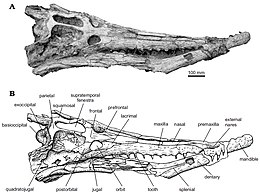Dyrosaurid
| Dyrosauridae Temporal range: 70–35 Ma Maastrichtian - Eocene |
|
|---|---|
 |
|
| Skull of the dyrosaurid Arambourgisuchus khouribgaensis | |
| Scientific classification | |
| Kingdom: | Animalia |
| Phylum: | Chordata |
| Class: | Reptilia |
| Suborder: | †Tethysuchia |
| Family: |
†Dyrosauridae de Stefano, 1903 |
| Genera | |
Dyrosauridae is a family of extinct neosuchian crocodyliforms that lived from the Late Cretaceous (Maastrichtian) to the Eocene. Dyrosaurid fossils are globally distributed, having been found in Africa, Asia, Europe, North America and South America. Over a dozen species are currently known, varying greatly in overall size and cranial shape. All were presumably aquatic, with species inhabiting both freshwater and marine environments. Ocean-dwelling dyrosaurids were among the few marine reptiles to survive the Cretaceous–Paleogene extinction event.
Dyrosaurids were once considered an African group, but discoveries made starting from the 2000s indicate they inhabited the majority of the continents. In fact, basal forms suggest that their cradle may have been North America.
Jouve et al. (2005) diagnose Dyrosauridae as a clade based on the following seven synapomorphies or shared characters:
Below is a cladogram after Jouve et al. (2005) showing phylogenetic relationships of Dyrosauridae and other closely related neosuchians:
Eutretauranosuchus
Elosuchus
Sarcosuchus
Terminonaris
Chenanisuchus
Sokotosuchus
Phosphatosaurus
Dyrosaurus
Arambougisuchus
Congosaurus
Hyposaurus rogersii
Rhabdognathus rarus
Rhabdognathus sp.
Composite cladogram for Dyrosauridae (from Jouve et al. 2008 and Barbosa et al. 2008):
Chenanisuchus
Sokotosuchus
Phosphatosaurus
Dyrosaurus
Arambourgisuchus
Guarinisuchus
Hyposaurus
Congosaurus
Atlantosuchus
Rhabdognathus
Dyrosauridae incertae sedis: Tilemsisuchus
Cladogram after Hastings et al. (2011) showing geographic occurrences of taxa:
...
Wikipedia
